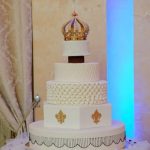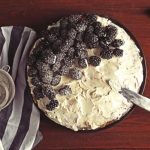Are you looking to add a little extra flair to your fondant cake? In this article, we will explore the key techniques and tips for sticking decorations on fondant cakes.
From choosing the right decorations to troubleshooting common issues, we’ll cover everything you need to know to ensure your cake decorations stay put. Whether you’re a beginner or an experienced baker, understanding the importance of properly sticking decorations on a fondant cake is crucial for achieving a professional-looking and impressive final product.
When it comes to decorating a fondant cake, the type of decorations you choose plays a significant role in not only enhancing the overall aesthetic but also determining how they are applied. From edible flowers and sugar pearls to fondant cutouts and decorative patterns, there is a wide range of decorative options available for fondant cakes.
It’s important to carefully consider the type of decorations that best suit your design vision as well as the specific techniques required for effectively adhering them to the fondant surface.
Before diving into the application process, preparing the fondant surface is essential for ensuring that decorations adhere securely and remain in place. Properly kneading and rolling out the fondant, as well as smoothing it onto the cake, sets the foundation for successful decoration application.
Additionally, taking into account factors such as humidity and temperature can greatly impact how well decorations stick to the fondant surface. Through this article, we will delve into various preparation techniques that will optimize the adherence of decorations on your fondant cake.
Choosing the Right Decorations
When it comes to decorating a fondant cake, choosing the right decorations is crucial to achieving the desired outcome. There are various types of decorations suitable for fondant cakes, each with its own unique characteristics and application methods. From edible flowers and sugar pearls to fondant cutouts and chocolate molds, the options are truly endless. The key is to select decorations that not only complement the theme or occasion but also adhere well to the fondant surface.
For a wedding cake, delicate sugar flowers or elegant lace designs made from royal icing can create a stunning and sophisticated look. On the other hand, a child’s birthday cake may call for playful fondant shapes, colorful sprinkles, or edible glitter for a fun and whimsical touch. It’s important to consider the overall design of the cake and choose decorations that align with the theme while keeping in mind how they will stick onto the fondant surface.
In addition to considering aesthetics, it’s also important to take into account the size and weight of the decorations. Heavier decorations may require stronger adhesive or additional support within the cake itself to prevent them from sliding down or falling off. By carefully selecting decorations based on their suitability for fondant cakes, you can ensure that they not only look beautiful but also stay securely in place throughout your event.
| Choosing Decorations | Considerations |
|---|---|
| Edible Flowers | Lightweight, fragile; may require delicate handling |
| Sugar Pearls | Add elegance and texture; adhere easily with edible glue |
| Fondant Cutouts | Customizable shapes and designs; adhere well with water or gum paste adhesive |
| Chocolate Molds | Create intricate details; secure with melted chocolate or royal icing |
Preparing the Fondant Surface
Fondant Smoothing
Before you start sticking decorations on your fondant cake, it’s important to ensure that the fondant surface is smooth and free of any cracks or creases. Use a fondant smoother to gently press down on the surface, starting from the top and working your way down to the sides.
Applying a Thin Layer of Water or Edible Adhesive
One effective way to help decorations stick to fondant is by applying a thin layer of water or edible adhesive on the area where you want to place the decorations. Use a small brush or spray bottle to lightly dampen the fondant surface before carefully placing the decorations.
Avoiding Moisture Build-Up
While adding moisture can help with sticking decorations, it’s important to avoid excessive moisture build-up on the fondant surface as it can cause colors to bleed and affect the overall appearance of the cake. Use a light touch when applying water or edible adhesive and allow it to dry slightly before placing any decorations.
By following these tips and techniques for preparing the fondant surface, you can ensure that your decorations stick securely without compromising the look of your fondant cake. Experiment with different methods to find what works best for you and your specific decoration needs.
Edible Adhesives
When it comes to sticking decorations on a fondant cake, using the right edible adhesive is crucial. Edible adhesives are specially designed to adhere to the fondant surface without altering the taste or texture of the cake. There are several types of edible adhesives that can be used, each with its own unique properties and applications.
One popular option for edible adhesive is royal icing, which is made from confectioners’ sugar and egg whites or meringue powder. Royal icing dries hard, making it ideal for securing heavier decorations such as sugar flowers or fondant figurines. Another common edible adhesive is gum glue, which is made by dissolving gum paste in water to create a sticky paste that can be used to attach delicate decorations like sequins or small edible pearls.
In addition to royal icing and gum glue, piping gel is also commonly used as an edible adhesive for fondant cakes. Piping gel has a clear consistency and can be applied with precision using a small brush, making it perfect for attaching wafer paper designs or intricate lace patterns onto the surface of the fondant.
Using the right edible adhesive can make all the difference when it comes to successfully decorating a fondant cake. Understanding the different types of edible adhesives and their applications will ensure that your decorations not only stick securely but also look visually appealing on your cake.
| Type of Edible Adhesive | Applications |
|---|---|
| Royal Icing | Suitable for heavy decorations such as sugar flowers or fondant figurines |
| Gum Glue | Ideal for delicate decorations like sequins or small edible pearls |
| Piping Gel | Perfect for attaching wafer paper designs or intricate lace patterns |
Non-Edible Adhesives
When it comes to sticking decorations on fondant cakes, there are alternative options to edible adhesives that can be used. While edible adhesives are the preferred choice for most decorators, non-edible adhesives can also be effective and sometimes necessary for certain types of decorations.
Double-Sided Tape or Glue
One option for non-edible adhesives is using double-sided tape or glue. This option is best suited for decorations that will be removed before serving the cake, such as ribbon or paper cutouts. It’s important to ensure that the tape or glue used is food-safe and will not transfer any harmful chemicals onto the cake.
Modeling Chocolate or Royal Icing
Another non-edible adhesive option is using modeling chocolate or royal icing. These can be used to attach heavier decorations or to create a strong base for lightweight decorations. Modeling chocolate can be molded and shaped to create a secure hold, while royal icing can act as a strong “glue” for attaching items like flowers or figures.
Spray Adhesive
For larger decorations or intricate designs, spray adhesive can be an effective non-edible adhesive option. When using spray adhesive, it’s important to carefully follow the instructions and ensure that the cake is not directly exposed to the spray. This method should be used with caution and only by experienced decorators.
It’s important to note that when using non-edible adhesives on fondant cakes, it’s crucial to inform clients or guests about which parts of the decoration are not meant to be eaten. Clear labeling and communication about which parts of the cake are safe to consume is essential when using non-edible adhesives.
By exploring these alternative options, decorators can have more flexibility in their design choices and effectively stick decorations on fondant cakes without compromising on aesthetics or safety.
Technique Tips
When it comes to decorating a fondant cake, knowing how to stick decorations on the surface is an essential skill. Properly adhering decorations not only ensures that they stay in place, but it also contributes to the overall aesthetic appeal of the cake. In this section, we will provide step-by-step instructions for effectively and securely sticking decorations on fondant cakes.
Step-by-Step Instructions
Here are some technique tips for sticking decorations on a fondant cake:
1. Use edible adhesive: There are several types of edible adhesives that can be used to stick decorations onto a fondant cake. Some popular options include royal icing, gum glue, and melted chocolate. These adhesives provide a strong hold while being safe for consumption.
2. Apply a small amount of adhesive: When using edible adhesives, it’s important to use them sparingly to avoid any excess seeping out from under the decorations. Use a small brush or toothpick to apply a thin layer of adhesive to the back of each decoration before gently pressing it onto the fondant surface.
3. Consider non-edible adhesives: In some cases, you may need to use non-edible adhesives such as double-sided tape or clear piping gel for certain decorations that are not meant for consumption. Be mindful of where these non-edible adhesives are placed on the cake so that they do not come into contact with any portions that will be consumed.
It’s important to note that different types of decorations may require specific techniques when it comes to sticking them onto a fondant cake. By following these step-by-step instructions and experimenting with different methods, you can achieve beautifully decorated fondant cakes without worrying about decorations falling off.
Troubleshooting
When it comes to creating a beautifully decorated fondant cake, one of the biggest challenges can be ensuring that the decorations stick properly. There’s nothing worse than spending time and effort on intricate decorations, only to have them fall off or not adhere as desired. In this section, we will explore common issues that can arise when sticking decorations on fondant cakes and provide practical solutions to ensure a successful outcome.
One common issue that many bakers encounter is decorations sliding or falling off the fondant surface. This can happen for a variety of reasons, including excess moisture on the fondant or inadequate application of the adhesive.
To prevent decorations from sliding, it’s important to make sure that the fondant surface is completely dry before applying any decorations. Additionally, using too much adhesive can cause decorations to slip, so it’s crucial to apply a thin, even layer for optimal results.
Another common problem is decorations not adhering properly to the fondant surface. This can be especially frustrating when working with heavier or bulkier decorations. In this case, using the right type of adhesive is key. Edible adhesives such as royal icing or edible glue are great options for securing heavier decorations onto fondant cakes. These types of adhesives provide a strong hold without compromising the overall look and taste of the cake.
Lastly, air bubbles trapped underneath decorations can also cause them to come loose from the fondant surface. To avoid this issue, it’s important to gently press down on each decoration after it has been applied to release any trapped air and ensure a secure attachment. By following these troubleshooting tips and solutions, you can successfully address common issues with decorations not sticking properly on fondant cakes and create stunning and long-lasting designs for your baked creations.
Final Touches
In conclusion, properly sticking decorations on a fondant cake is crucial for creating a beautifully decorated and visually appealing dessert. From choosing the right decorations to preparing the fondant surface and applying edible and non-edible adhesives, there are several important steps to consider in order to achieve a well-decorated fondant cake. By following the techniques and tips outlined in this article, you can ensure that your decorations will adhere securely and enhance the overall appearance of your cake.
One important aspect to remember when sticking decorations on a fondant cake is to choose the right type of adhesive. Whether you opt for edible adhesives such as royal icing or gum paste glue, or non-edible options like melted chocolate or piping gel, it’s essential to select an adhesive that will effectively stick your decorations without compromising the taste or appearance of your cake.
By understanding the different types of adhesives available and their specific applications, you can determine which option is best suited for your desired decorations.
Additionally, taking the time to troubleshoot common issues with decorations not sticking properly on fondant cakes can help resolve any unforeseen challenges during the decorating process. Whether it’s addressing humidity-related issues, adjusting application techniques, or finding alternative adhesives, being prepared to troubleshoot potential problems can ultimately lead to a successful and well-decorated fondant cake.
With attention to detail and consideration of these final touches and additional tips, you can confidently create a stunning masterpiece that will impress both visually and tastefully.
Frequently Asked Questions
How Do You Stick Decorations to Fondant?
When sticking decorations to fondant, it’s important to use a small amount of water or clear alcohol like vodka. Using a paintbrush, lightly brush the back of the decoration with the liquid and then gently press it onto the fondant.
How Do You Stick Sprinkles to Fondant Cake?
To stick sprinkles to a fondant cake, you can use either clear piping gel or edible adhesive. Simply dab a small amount of the gel or adhesive onto the spot where you want the sprinkles and then sprinkle them on top while it’s still sticky.
How Do You Make Edible Glue for Fondant Cake Decorations?
Making edible glue for fondant cake decorations is easy and only requires two ingredients: tylose powder and water. Simply mix a small amount of tylose powder with water until it forms a thick, glue-like consistency. This can be used to attach fondant decorations securely to your cake without leaving any visible residue.

Welcome to my blog about home and family. This blog is a place where I will share my thoughts, ideas, and experiences related to these important topics. I am a stay-at-home mom with two young children. I hope you enjoy reading it! and may find some helpful tips and ideas that will make your home and family life even better!





